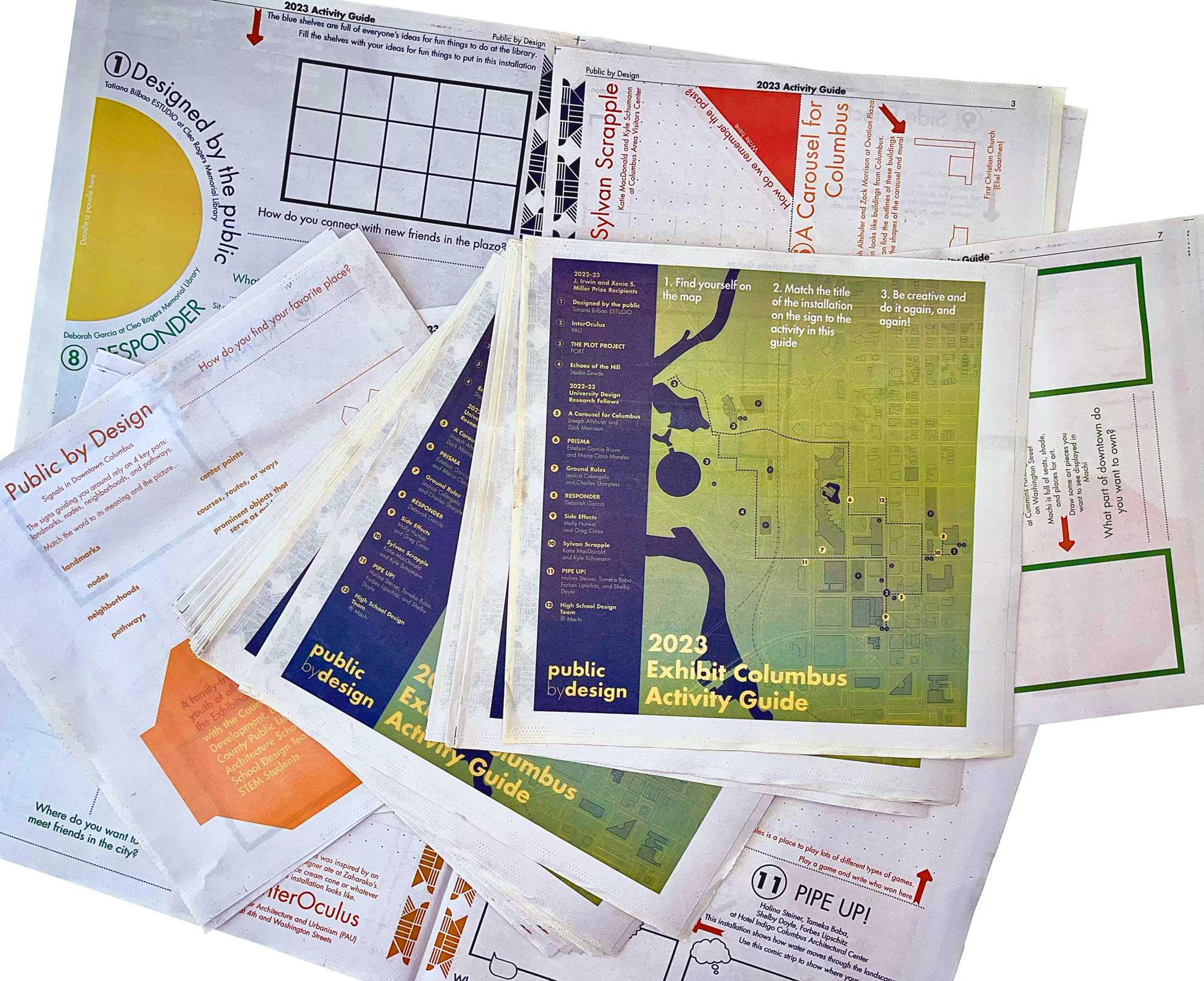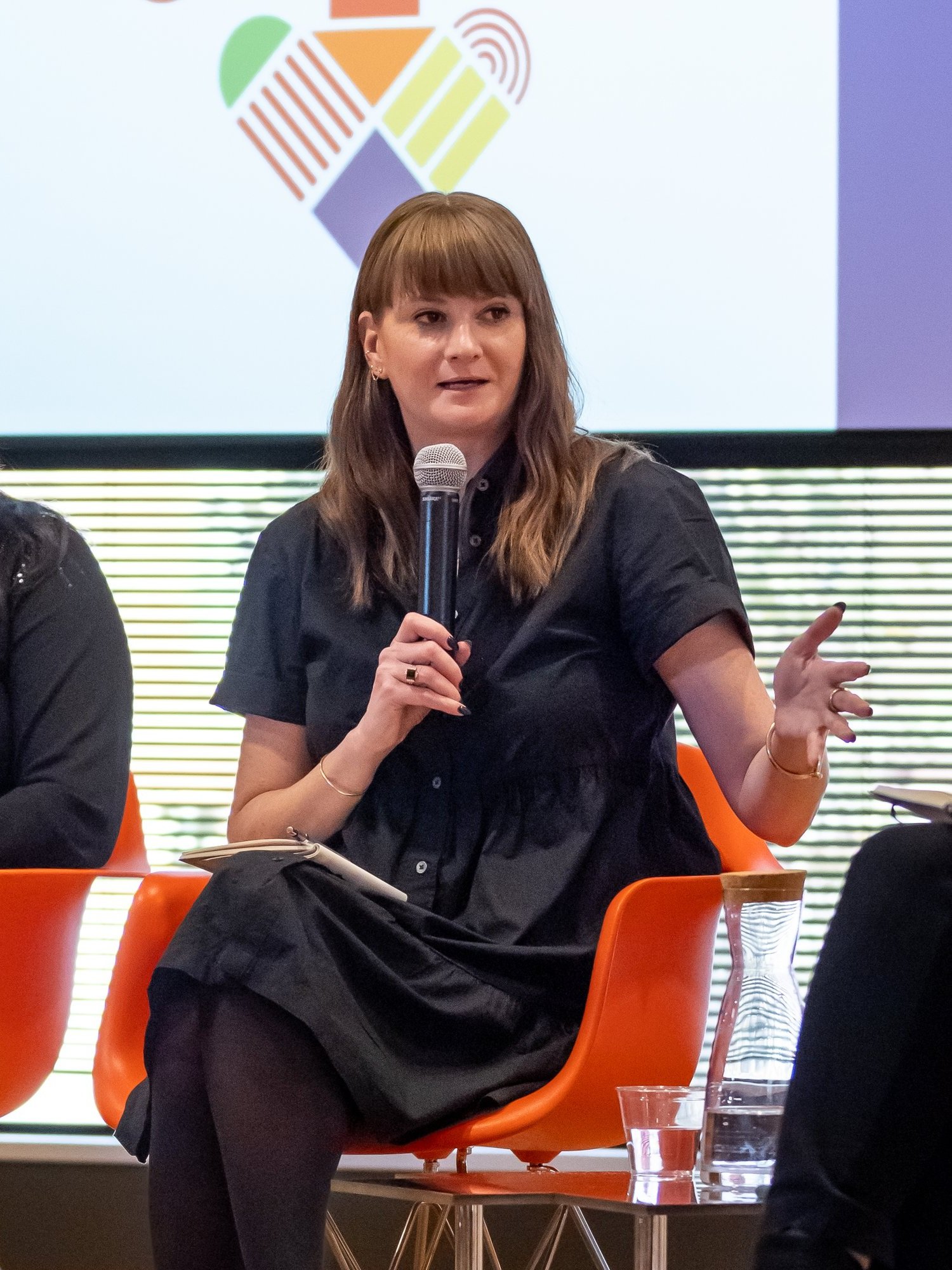
UDRF
●
Halina, Tameka, Forbes, and Shelby
●
PIPE UP!
●
Presented by Columbus Area Visitors Center
●
UDRF ● Halina, Tameka, Forbes, and Shelby ● PIPE UP! ● Presented by Columbus Area Visitors Center ●
PIPE UP! makes visible the subterranean water infrastructure of urban development and agricultural production, telling a visual, kinesthetic story about altered hydrologies. A vast network of buried pipes moves water throughout the built environment. They can also transport excess nutrients, dissolved pollutants, and sediment-bound toxins to downstream water bodies, contaminating freshwater sources and impairing the health and vitality of aquatic ecosystems.
Composed of four elements using off-the-shelf products, PIPE UP! is a standing field of 150 charlotte pipes topped by 700 feet of undulating tile drains. There are three suspended rain clouds made of flagging tape and 12 poufs representing toxic sediment scattered across the site help to create a vibrant and tactile display of invisible infrastructure. PIPE UP! seeks to facilitate events and conversations about the future role of water in local riparian corridors and across the Mississippi River Watershed Basin.
Accessibility
The exhibit is located in a grassy area. The grass may be uneven and damp due to weather but is relatively flat. The structure can be viewed easily from a nearby sidewalk.
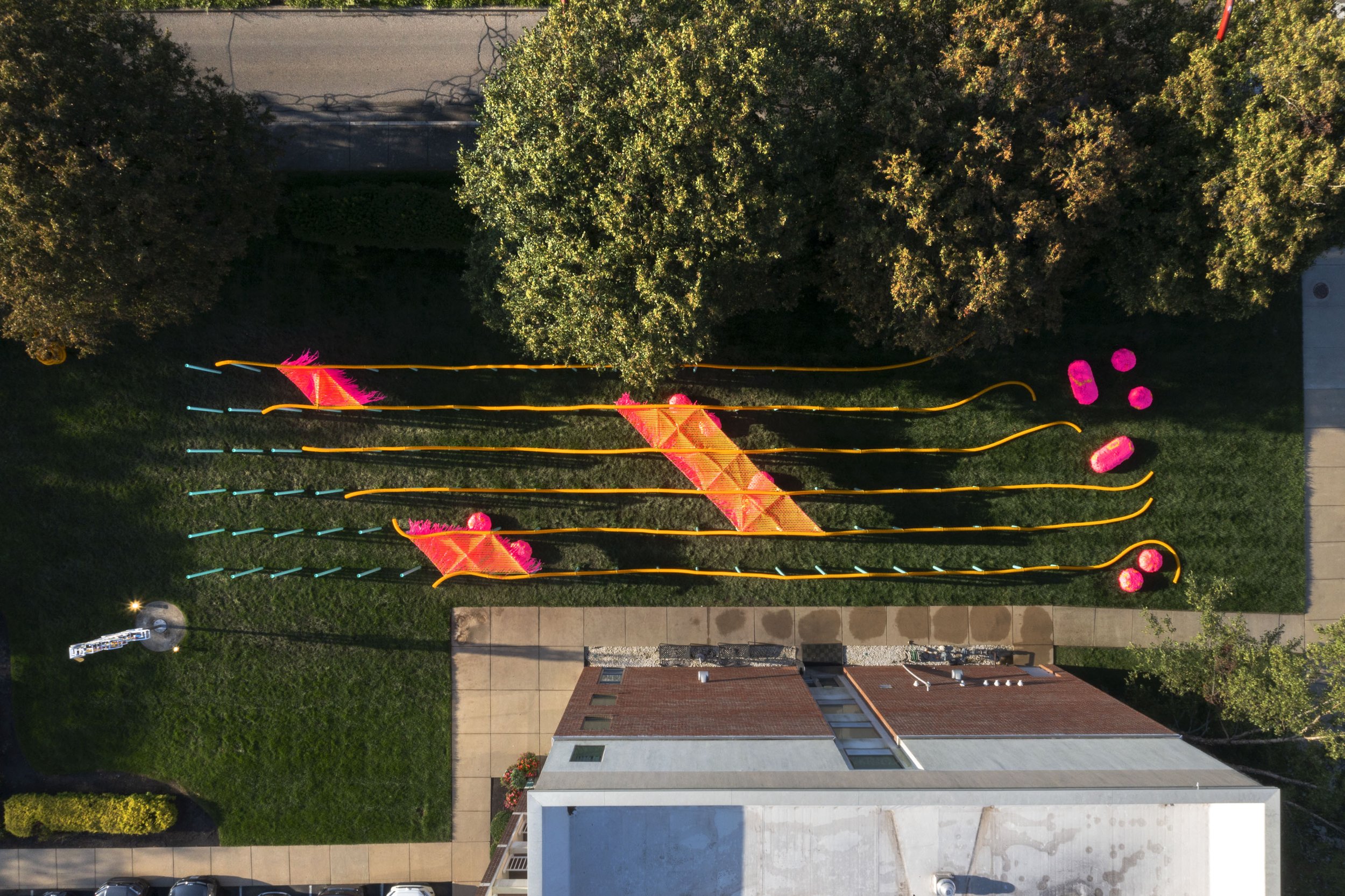
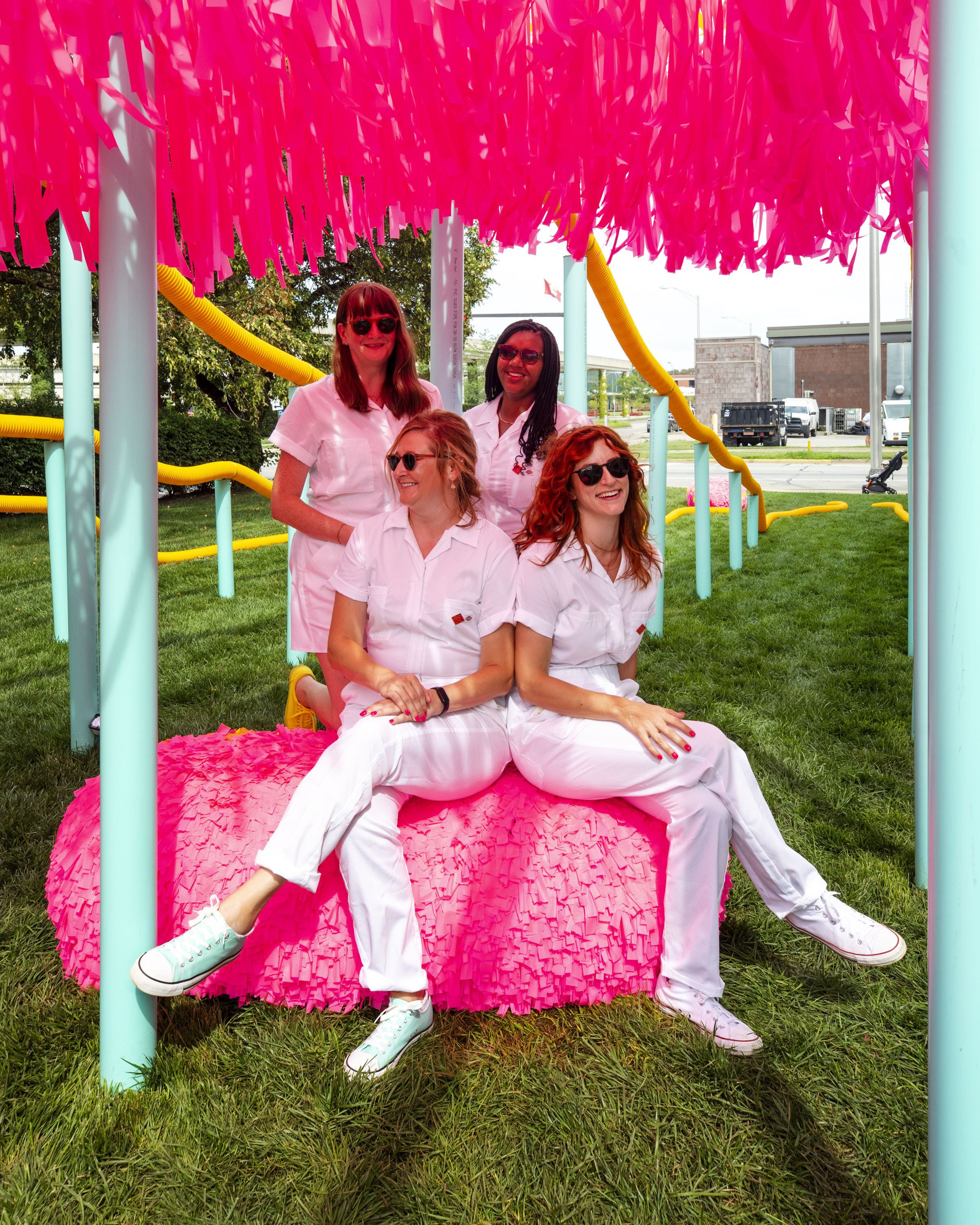
Where does your water go?

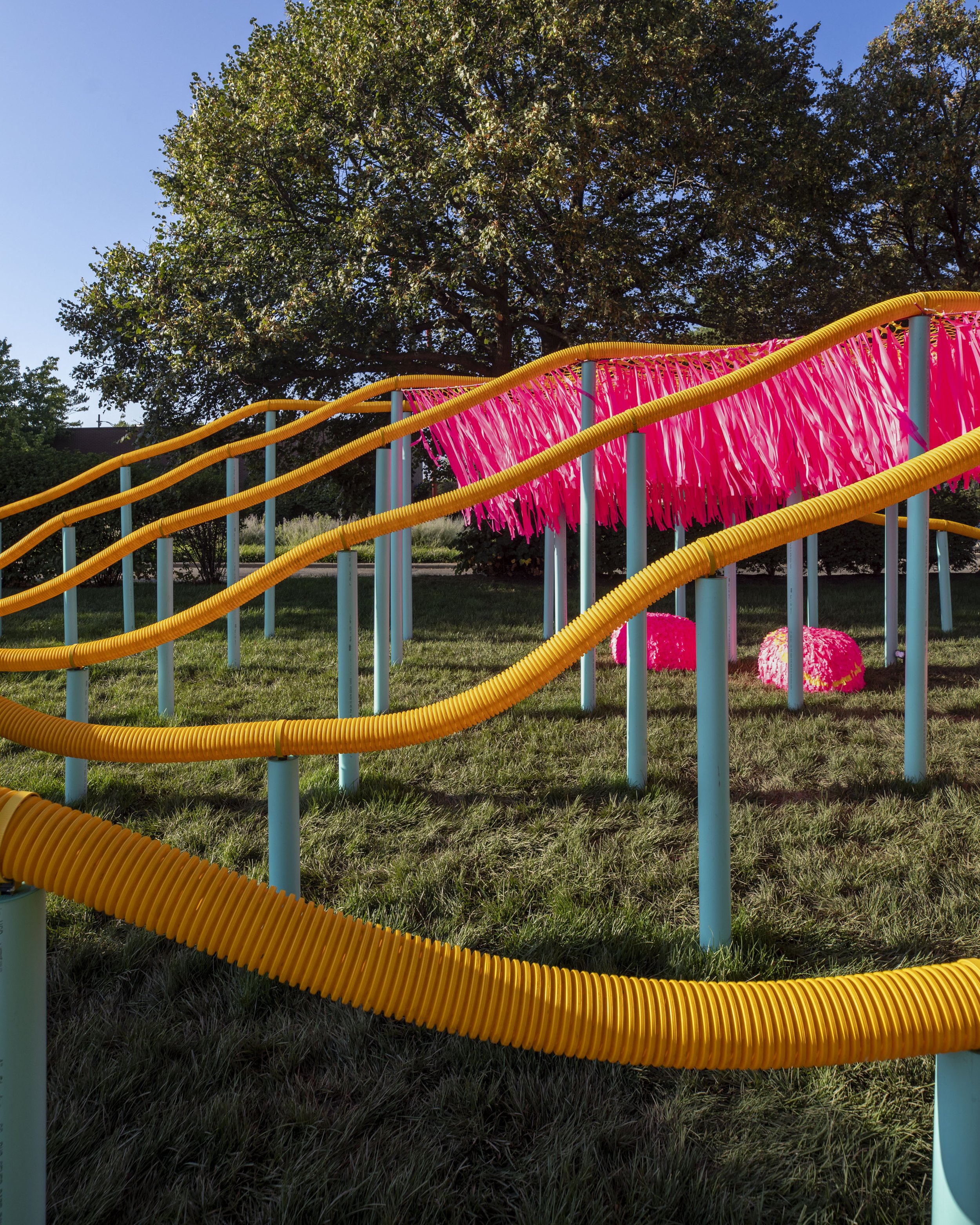
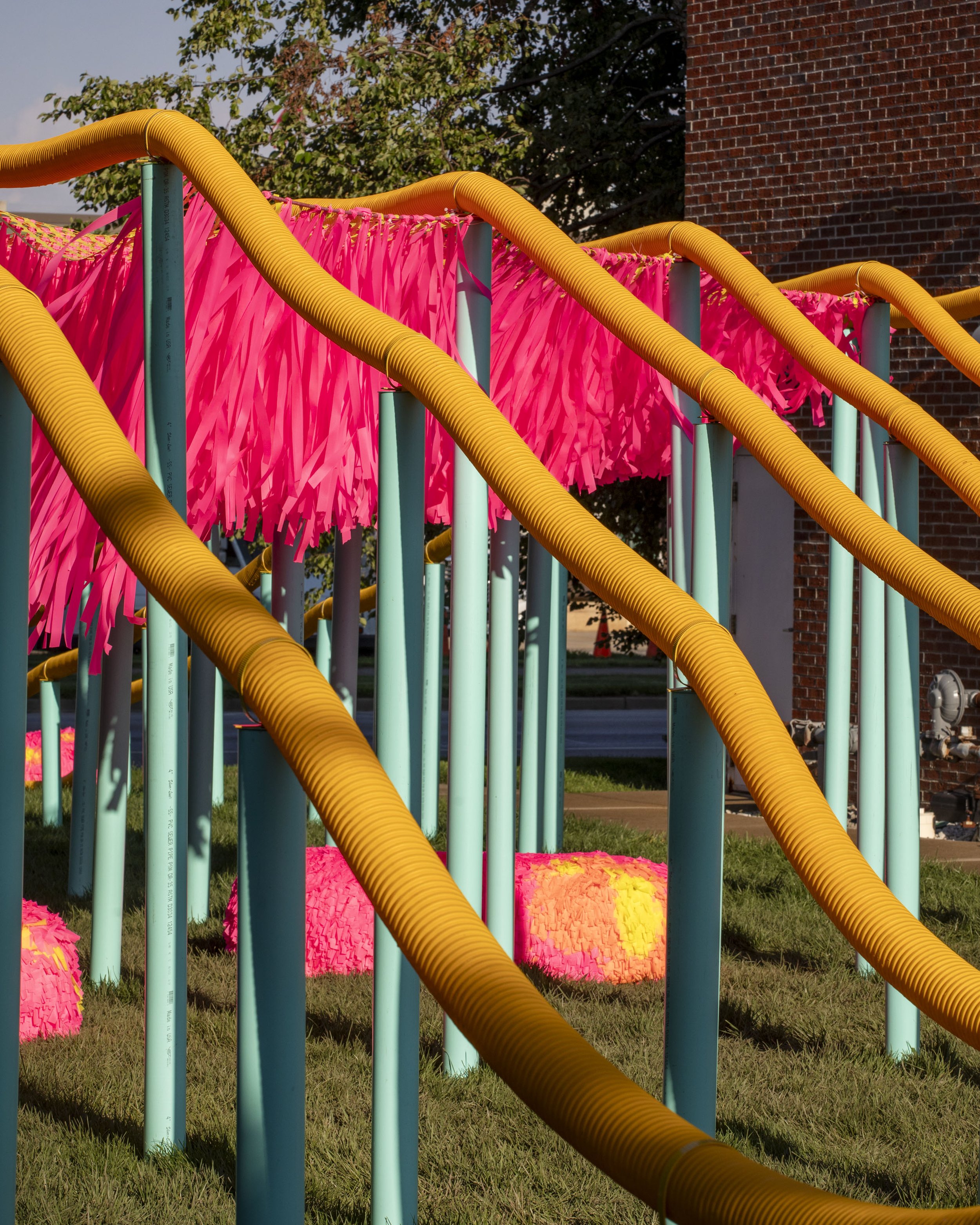



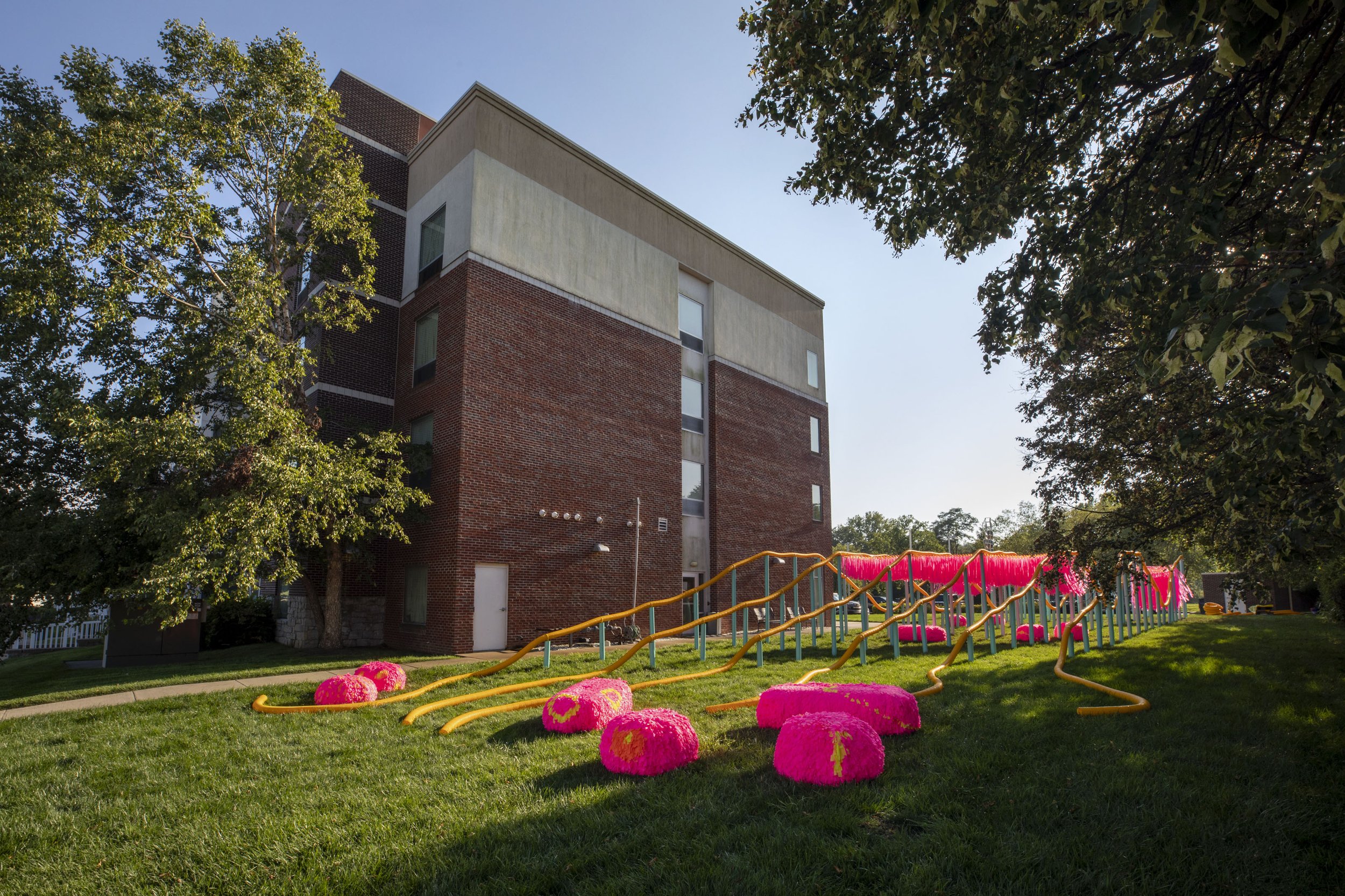
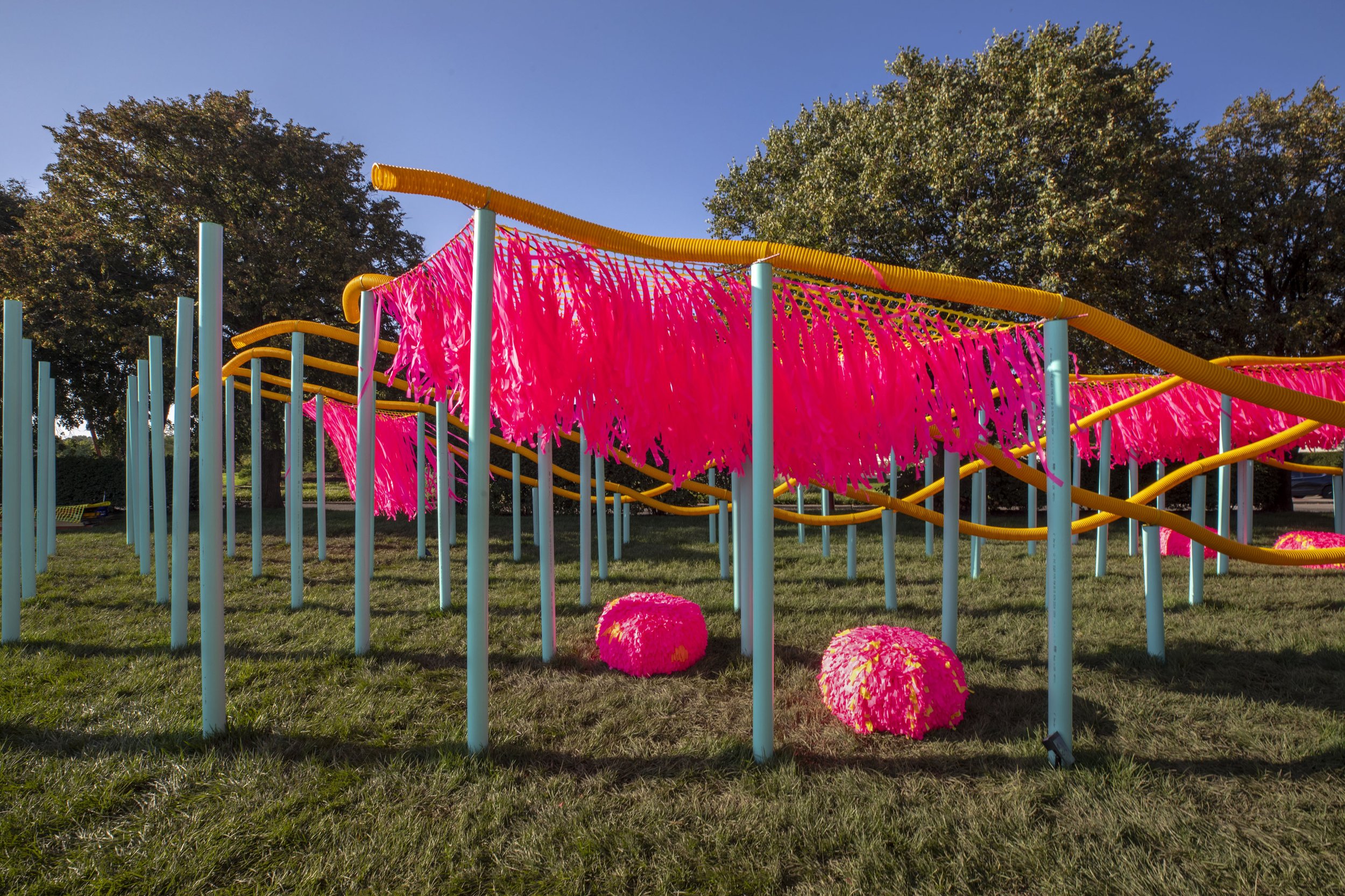
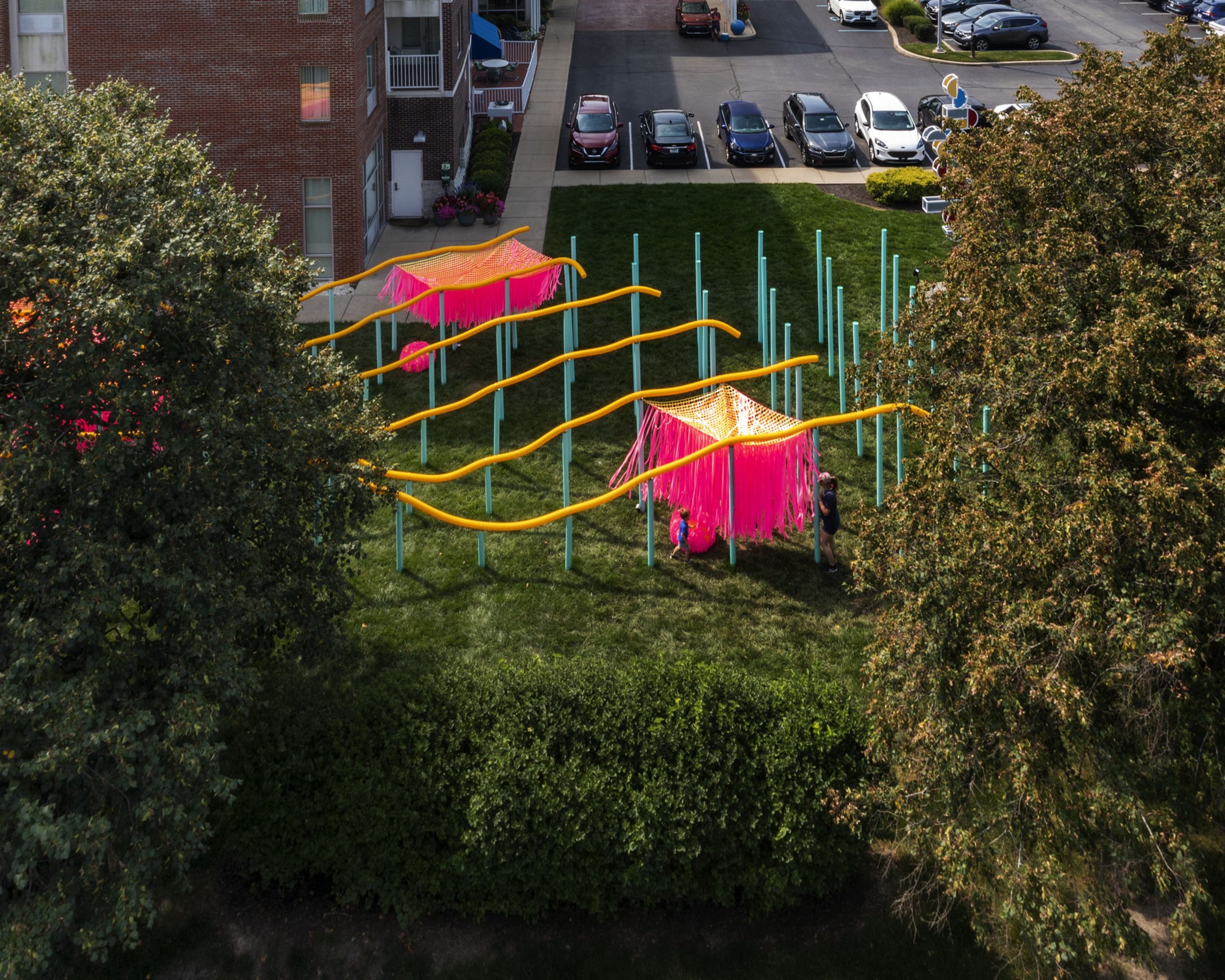
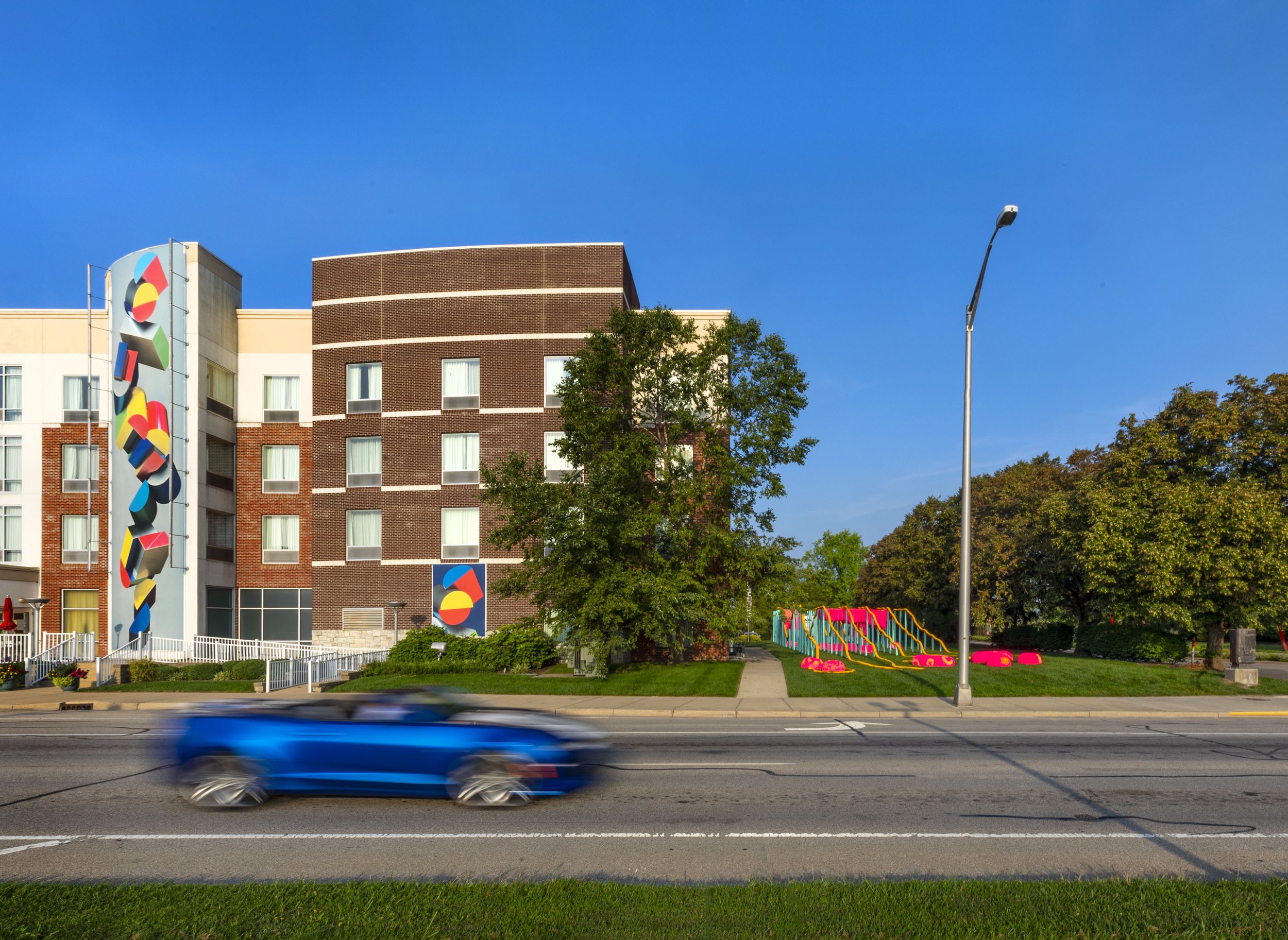
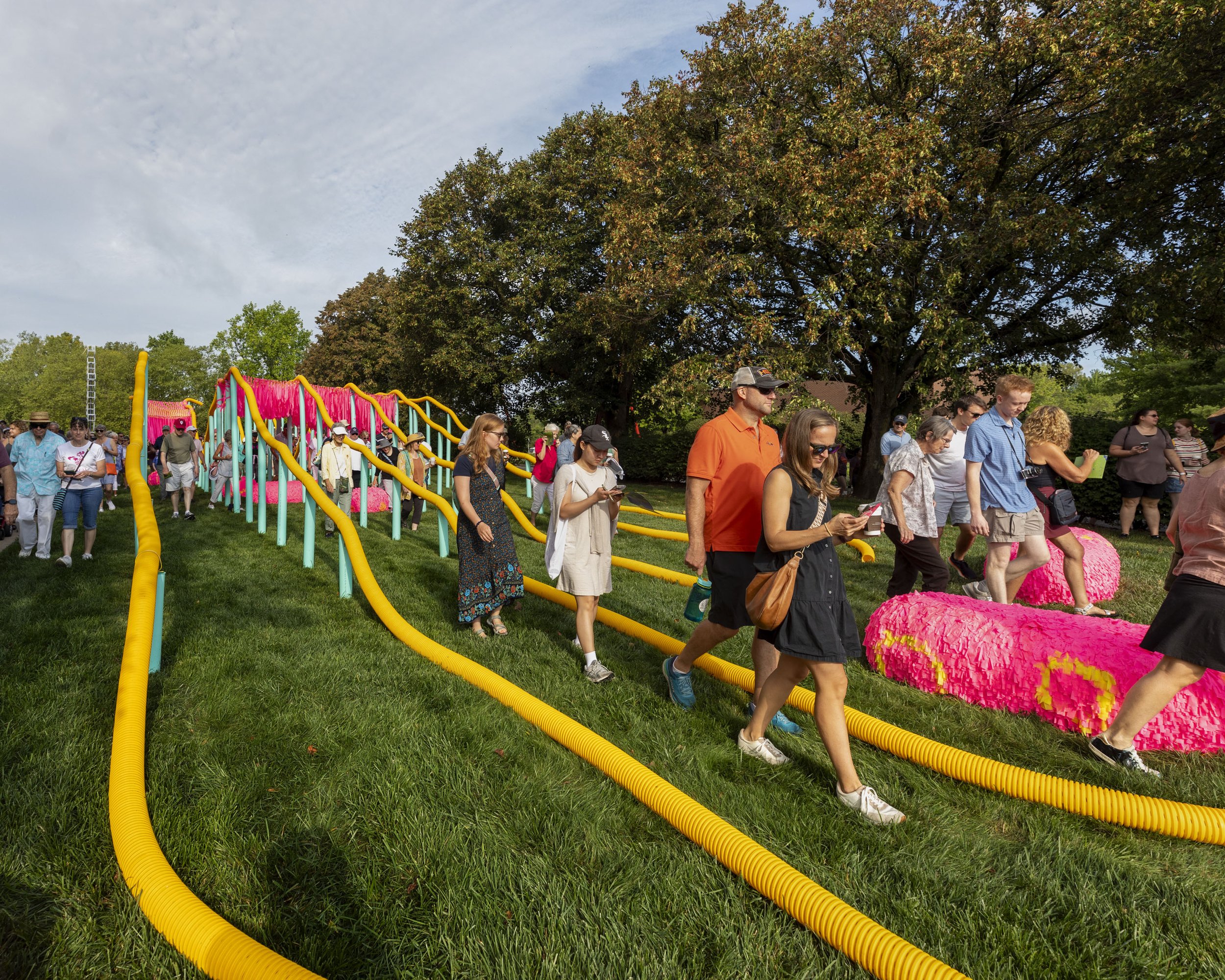
PIPE UP! Installation Credits
University Design Research Fellowship
Presented by
Columbus Area Visitors Center
Site and Collaborator
Hotel Indigo Columbus Architectural Center
University
Austin E. Knowlton School at The Ohio State University and Iowa State University College of Design
Team
Tameka Baba
Forbes Lipschitz
Shelby Doyle
Halina Steiner
Materials
Tile drains, Charlotte pipes, Flagging tape, Pipe hangers, Pipe insulation, Construction fence, Rebar
Fabrication Supporters
Generous tile drain donation by Baughman Tile Co.
Fabrication and design support by OSU Landscape Architecture students Blake Chapman and Maggie Chafin
25 students from the Center for Architecture and Design High School Design Studio
20 Pouf party volunteers from the Columbus, Ohio community
Additional Credits
Hotel Indigo
Columbus Architectural Center
Knowlton School MAT/FAB Lab
College of Engineering at The Ohio State University
Iowa State University College of Design
Financial and administrative support from Knowlton School
Site and Collaborator: Hotel Indigo Columbus Architectural Center
Creating PIPE UP!
Curatorial Question
Where does your water go?
“Its location at the edge of downtown acts as both a corridor and collector, drawing people to the installation while nudging visitors toward the riverfront to make the physical connections between urban and rural water infrastructure visible.”
Working on PIPE UP! and Exhibit Columbus allowed them to find overlaps in their work through water infrastructure from multiple disciplinary positions of landscape architecture, rural and urban planning, and architecture. They aspire to continue to find ways to come together to explore the proposition made by Public by Design that design is connected to public places and public institutions.
Tameka Baba received a B.A. in architecture studies from Kent State University and an M.A. in landscape architecture from Ohio State. The first project she worked on was a community garden on a vacant lot of a former lumberyard. The project allowed 12 stakeholder organizations to use the site to grow food for food pantries, mobile clinics, and classes on healthy eating. Now her work explores methods and techniques to create organic textiles to fabricate site objects and activities that engage community participation on vacant sites. Much of her work is developed through community engagement, and the theme of Public by Design reflects her interest in shaping landscapes through participatory design.
Forbes Lipschitz, from Little Rock, Arkansas, built her own major in environmental aesthetics at Pomona College, where she received a B.A. before earning an M.A. in landscape architecture from the Harvard Graduate School of Design. The first public installation she built was Privy 2. Along with an anthropologist, an architect, and a team of students, she installed a large pavilion made of recycled plastics in a field of corn fertilized with biosolids in the middle of OSU’s central Columbus campus. Today her work centers on reshaping and reframing agricultural landscapes through exhibitions, installations, and participatory workshops. She is also writing a book visualizing the landscape of animal agriculture. PIPE UP! has allowed her to show how agricultural drainage systems can be just as complexly engineered as urban ones.
Shelby Doyle was raised in Virginia and got her B.S. in architecture from the University of Virginia in Charlottesville before earning a master’s degree in architecture at the Harvard Graduate School of Design. Her first project was designing a house to withstand a category three hurricane for CookFox Architects in New York. Her career has been a series of projects exploring digital fabrication, construction, public design, and water. PIPE UP! has been an opportunity to bring these topics together.
Halina Steiner has lived primarily in Arizona. She received her B.S. in visual communication from The Design School at Arizona State University and an M.A. in landscape architecture from the Bernard and Anne Spitzer School of Architecture, The City College of New York, City University of New York. Her first built project as an intern involved creating access to a part of Brooklyn's waterfront. The project cost less than $3 a square foot and significantly impacted the community. It taught her that temporary spaces can be very important to communities, especially those faced with the lengthy design process of many public projects. Her work now examines how to improve water quality and water literacy through pilot projects, installations, and visual communication. Her work revealing hidden infrastructure and issues tied to hydrology aligns well with PIPE UP! she said.
Currently, Halina is developing a project that will activate a vacant plot using a choreographed dance of planted vessels, tracking their movements and growth as they integrate with the site over 18 weeks in the summer of 2024.
A big focus of her career has been revealing rural landscapes' hidden and overlooked complexities to an urban audience.
She is also working on digital fabrication and design-build projects that engage with small towns and non-profits, as well as prototyping 3D printed housing for rural communities designed for storm resilience.
She just completed constructing a pilot project called “Curbing Sediment,” which aims to collect first-flush toxins from roadways before entering water bodies.
This excerpt is from the 2023 Field Guide. Download it here.
Activity Guide for kids and families to explore the Exhibition.
Download the activity for the installation PIPE UP!. Print at home, or stop by any Infohub to pick up a free guide.
2023 Design Presentations
PIPE UP! installation design concept by 2022–23 University Design Research Fellows BLDS (Tameka Baba, Forbes Lipschitz, Shelby Doyle, and Halina Steiner) from Austin E. Knowlton School at The Ohio State University and Iowa State University College of Design in Columbus, Ohio and Ames, Iowa.
“As a landscape architect, my work has primarily been focused on the cross section between the public and design. The design of a pop-up park, a pilot project, masterplan, or public space are largely dependent on expertise provided by the public. The public will know their neighborhood better than any designer and the synergy between the two is where meaningful design can happen.” — Halina Steiner (pictured speaking at microphone) with team members Shelby Doyle, Tameka Baba, and Forbes Lipschitz.
2022 Symposium
Halina Steiner in discussion with other UDRFellows and the Curatorial Team at the 2022 Symposium in October. Take a look back at the 2022 Symposium here.
University Design Research Fellows
Tameka Baba, Forbes Lipschitz, Shelby Doyle, and Halina Steiner
Austin E. Knowlton School at The Ohio State University and Iowa State University College of Design
Columbus, OH and Ames, IA
Halina Steiner is Assistant Professor of Landscape Architecture at the Austin E. Knowlton School at The Ohio State University. Her research, Forensic Hydrology, focuses on overlaps between professional practice, hydrology, and infrastructure with an emphasis on scale and systems. This interest comes from her prior work as Design Director for DLANDstudio in New York City where she led master planning, green infrastructure, temporary installations, and public design projects in New York, St. Louis, New Orleans, Philadelphia, and Nigeria.
Tameka Baba is Assistant Professor of Practice in Landscape Architecture at the Austin E. Knowlton School at The Ohio State University. Her research tracks the transition of urban vacancy, specifically those created by the retail industry. Within these landscapes her work aims to develop a system of temporary and long-term design solutions that create places for communities to exchange goods and cultures. She served as the design lead of South Jackson Community Garden located in Lima, Ohio as part of the Ohio Land Exchange program.
Forbes Lipschitz is Associate Professor of Landscape Architecture at the Austin E. Knowlton School at The Ohio State University. Her research investigates the potential of design to reframe and reshape conventional working landscapes. Through public installations and participatory workshops, she explores ways for design to help communities better understand and engage with agricultural systems. Her research and creative work has been published nationally and internationally.
Shelby Doyle is Associate Professor of Architecture and Stan G. Thurston Professor of Design Build at the Iowa State University College of Design (ISU). She is also Co-Founder of the ISU Computation & Construction Lab, and Director of the ISU Architectural Robotics Lab. The central hypothesis of CCL and Doyle’s work is that computation in architecture is a material, pedagogical, and social project; computation is both informed by and productive of architectural cultures.
Existing work by BLDS
Sedimentary State: Under the Microscope The installation magnified the issue of ‘first flush toxins’ on a typical city street via student designed stools of abstracted toxins such as sediment, trash, oil, grease, and metals anchored in a stormwater carpet. Team: Tameka Baba, Halina Steiner, Avee Oabel, Julia Cheung, Caroline Duque, Dylan Hart, Colin Martinez-Watkins, Madison Miller, Sophie Pawlak, Drew Williams, Andrew Polefrone Credit: Tameka Baba
Privy 2: Biosolids and You The installation featured an architectural pavilion, made with recycled material, sited in a field of corn fertilized with biosolids from the City of Columbus designed by interdisciplinary team of OSU faculty and public sector professionals to shed light on the processes by which human “waste” is transformed into an agricultural resource. Team: Forbes Lipschitz, Justin Diles, Nick Kawa. Credit: Phil Arnold
IMRU Through transparency, form, and light, IM_RU challenges users with reflections of their incomplete selves and considers the role of the individual in the summation of societal identity. Team: ISU CCL Credit: Christopher Gannon
















